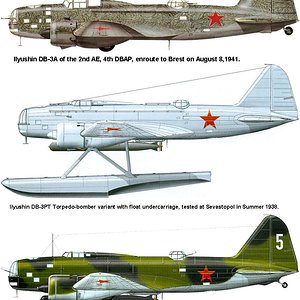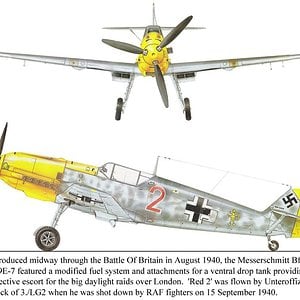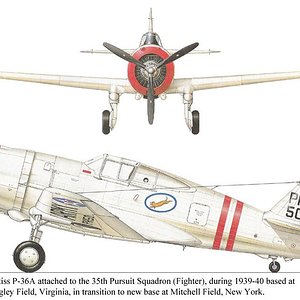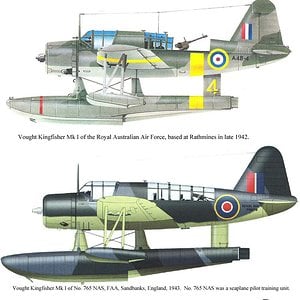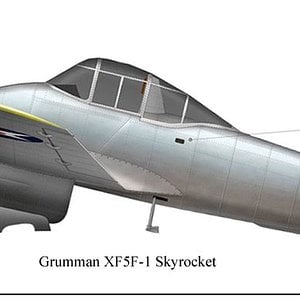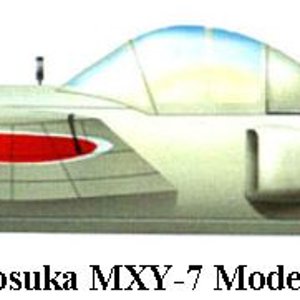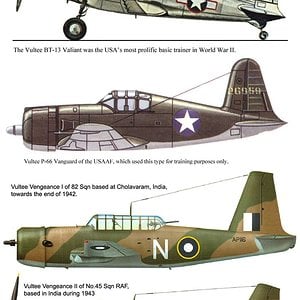Navigation
Install the app
How to install the app on iOS
Follow along with the video below to see how to install our site as a web app on your home screen.
Note: This feature may not be available in some browsers.
More options
You are using an out of date browser. It may not display this or other websites correctly.
You should upgrade or use an alternative browser.
You should upgrade or use an alternative browser.
The Vought OS2U Kingfisher was an American catapult-launched observation floatplane. It was a compact mid-wing monoplane, with a large central float and small stabilizing floats. Performance was modest, because of its light engine. The OS2U could also operate on fixed, wheeled, taildragger landing gear.
The OS2U was the main shipboard observation aircraft used by the United States Navy during World War II, and 1,519 of the aircraft were built. It served on battleships and cruisers of the US Navy, with the United States Marine Corps in Marine Scouting Squadron THREE (VMS-3), with the United States Coast Guard at coastal air stations, at sea with the Fleet Air Arm of the Royal Navy, and with the Soviet Navy. The Royal Australian Air Force also operated a few Kingfishers from shore bases
The XOS2U-1 prototype of this two-seat observation/scout monoplane was delivered to the US Navy in 1938 and the first production OS2U-1 went into service in 1940. Two further and generally similar series, the OS2U-2 and -3, followed - the latter also going into production at the Naval Aircraft Factory as the OS2N-1. The British Kingfisher I was a counterpart of the OS2U-3.
Two examples showing the plane's rescue capabilities include the recovery of World War I ace Eddie Rickenbacker and his crew from the Pacific in November 1942 and LT John A. Burns' unique use of the aircraft in April 1944 to taxi airmen rescued from the Truk Lagoon to the submarine USS Tang which was serving rescue duty near the atoll on that date. In all, LT Burns rescued 10 survivors on two trips and was awarded the Navy Cross for his efforts.
Total production amounted to about 1,925 aircraft.
Info:
Aviastar
http://www.aviastar.org/index2.html
Wikipedia
http://en.wikipedia.org/wiki/Vought_OS2U_Kingfisher
Profiles:
American Aircraft Of World War II
Published by Chancellor Press Ltd.
Wings Palette
http://wp.scn.ru/en/
The OS2U was the main shipboard observation aircraft used by the United States Navy during World War II, and 1,519 of the aircraft were built. It served on battleships and cruisers of the US Navy, with the United States Marine Corps in Marine Scouting Squadron THREE (VMS-3), with the United States Coast Guard at coastal air stations, at sea with the Fleet Air Arm of the Royal Navy, and with the Soviet Navy. The Royal Australian Air Force also operated a few Kingfishers from shore bases
The XOS2U-1 prototype of this two-seat observation/scout monoplane was delivered to the US Navy in 1938 and the first production OS2U-1 went into service in 1940. Two further and generally similar series, the OS2U-2 and -3, followed - the latter also going into production at the Naval Aircraft Factory as the OS2N-1. The British Kingfisher I was a counterpart of the OS2U-3.
Two examples showing the plane's rescue capabilities include the recovery of World War I ace Eddie Rickenbacker and his crew from the Pacific in November 1942 and LT John A. Burns' unique use of the aircraft in April 1944 to taxi airmen rescued from the Truk Lagoon to the submarine USS Tang which was serving rescue duty near the atoll on that date. In all, LT Burns rescued 10 survivors on two trips and was awarded the Navy Cross for his efforts.
Total production amounted to about 1,925 aircraft.
Info:
Aviastar
http://www.aviastar.org/index2.html
Wikipedia
http://en.wikipedia.org/wiki/Vought_OS2U_Kingfisher
Profiles:
American Aircraft Of World War II
Published by Chancellor Press Ltd.
Wings Palette
http://wp.scn.ru/en/


